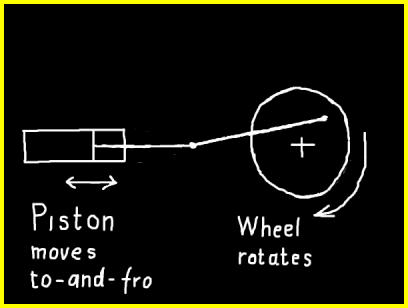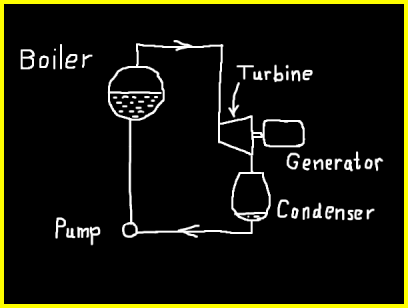6
The Steam Age That Didn’t End
Miss Tumble told the class that the era in which steam
engines were developed and used extensively was
known as the Steam Age. According to Miss
Tumble, before the
Steam Age mankind had to make do with human or
animal muscle power or the power of the wind or of
water to operate machines or do heavy work.
Newcomen’s steam engine marked the start of a
new era. Thomas Newcomen and other engineers
quickly found ways of improving the design of steam
engines so that they worked better and were less
expensive to make.

The movement of a piston turns a wheel
The rocking motion of
Newcomen’s steam engine was suitable for
operating pumps, but, for many applications rotary
motion was required: so said Miss Tumble. Other
steam engines were developed in which the to-an-fro
movement of a piston was converted to a rotary
motion of a wheel or shaft. Miss Tumble drew a
diagram to show what she meant.

Movement of a piston causing a wheel to turn
Many more
innovations followed in the development of
steam engines. One major improvement that was
made to early steam engines was the introduction of
a separate
condenser. Miss Tumble said the
condenser made good use of the condensation effect
that occurred on the mirror in Angela’s
bathroom. The condenser contained a large amount of
cold surface on which the steam condensed. Once
this improvement was introduced, the cylinders of
the steam engines didn’t have to be heated up
and cooled down for every cycle. This allowed steam
engines to be built that operated at higher speeds
and needed less fuel for the same work output.
James Watt was the inventor of the separate
condenser and he introduced many other improvements
as well.
Another major improvement,
which was made by a man called Richard Trevithick,
was the use of high-pressure steam in steam
engines. Miss Tumble explained that by enclosing
water in a boiler and heating it steam could easily
be produced at high pressure, but the boiler
would have to be strong enough to withstand the pressure of the
water and steam inside it. In the early days of
steam engines this was a real problem and accidents
occurred when steam boilers exploded. High pressure
steam was able to push much harder on the pistons
of steam engines. For a given size
of engine, running at a given speed, more work
could be produced if high pressure steam was used.
High pressure engines were more
efficient
than low pressure engines.
Miss Tumble said that Richard
Trevithick also invented the first self-propelled
vehicle. In order to do this he had to discard
Watt’s invention of the condenser, as it
would have been too big and heavy to carry around
in a vehicle. He decided to let the steam go up the
chimney instead, mixing with the smoke from the
fire. The escaping steam had the effect of pushing
the smoke out and drawing more air through the
fire. The fuel burned more easily as a result.
Trevithick’s engines were called
‘Puffers’ because the mixture of smoke
and steam came out in puffs from the chimney.
Of course, stationary engines
that had condensers were more efficient than
Trevithick’s engines for vehicles that
didn’t. Miss Tumble said that
Trevithick’s idea of leaving out the
condenser was a very good example of a compromise.
He had settled for lower efficiency in order to
make self-propelled vehicles practical. Miss Tumble
wrote COMPROMISE on the blackboard. Rose
volunteered to explain what compromise meant. She
said it was a best choice in between two other
choices that were not satisfactory. One day she had
wanted to play skipping in the school yard and Eve had wanted
to play chasing. They had compromised by playing
chasing for half their break time and skipping for
the other half.
Miss Tumble thanked Rose for that
example. She said that being able to compromise was
a very important skill to have. New inventions
often involved compromise, as in the case of
Trevithick’s vehicle.
Steam engines were built in
great numbers and in many sizes. They were used to
pump water out of mines so that coal could be
extracted from deep below the Earth’s
surface. They were used instead of animals to draw
coal wagons to bring the coal to the surface. Steam
engines were used in farming for threshing wheat.
They were used in factories to power machines that
made all kinds of products: from linen cloth to
nails to wooden furniture. Steam engines provided
power for trains and ships. Steam engines allowed
roads to be built more quickly and economically.
Geraldine asked Miss Tumble why people didn’t
use steam engines anymore. Miss Tumble said that
other types of engines had been invented since the
first
steam engines. Some of these, such as the petrol or
diesel engines
used in cars and the diesel
engines used in railway locomotives, were found to
be better than steam engines because they took up
less space, were cleaner, were quieter or used less
fuel. Miss Tumble told Geraldine her question was a
very good one and said that she herself still
wondered why there didn’t seem to be any
modern steam engines around.
Miss Tumble was not the type
of person to leave a question incompletely answered
for long. She soon resolved the question of modern steam engines. She
spoke to her sister-in-law, Ida Donut, who was a
mechanical engineer, and found out that modern
steam engines did exist after all. The modern form
of the steam engine was the steam power
plant. These were mostly used for
generating electricity in power stations. In effect
a steam power plant, such as the Moneypoint power
plant in County Clare, was a huge steam engine.
Instead of pistons that moved up and down or back
and forth, as in the early steam engines, turbines
were used. These rotated very
smoothly at a steady speed of 3,000 revolutions per
minute to drive electric generators that produced
the electricity. The most common form of modern
steam turbine was invented by the Irishman Charles
Parsons.
In a modern steam power plant
there was a boiler to produce high pressure steam,
a turbine to provide the power output and a
condenser to change the low pressure steam that
came out of the turbine back into liquid water.
There was also a pump to pump the condensed water
back into the boiler. Freddie asked if that meant
that the same water went around and around
inside the steam power plant, changing from water to steam
in the boiler and condensing again in the
condenser. Miss Tumble said that was correct.
Eve then had a brilliant idea:
she said it would be better to let the steam that
came out of the turbine go straight back into the
boiler. Then there would be no need for the
condenser or the pump. Miss Tumble agreed that that
sounded like a very good and sensible idea, but she
didn’t know why it was not done that way. She
promised to make some enquiries to find an explanation.

Steam power plant
Professor Leo Nest of the
University of Linnduv kindly gave Miss Tumble an
explanation over the phone as to why the condenser
and the pump were used. It was rather technical,
but Miss Tumble was able to explain it to the
children more simply. Any given amount of the
low-pressure steam coming out of the turbine took
up a great deal of space. It would have required a
very big pump to push all of this back into the
boiler against the high pressure of the steam and
water that were already inside. It would also have
taken so much work that nearly all of the work
produced by the
turbine would have to have been
used for this alone, leaving very little for the
production of electricity. However, when the
low-pressure steam was condensed, it became liquid
water, which took up very little space. A very
small pump could then be used to pump it back into
the boiler. This pump only required a small amount
of work to drive it. Therefore nearly all of the
work output of the turbine could be used to produce
electricity. Freddie was relieved to learn that
condensation was such an important part of steam
power plants after all.
Professor Nest also gave Miss
Tumble his opinion as to why steam engines were not
in common use in such applications as cars,
lawnmowers or aeroplanes. In the case of aeroplanes
he considered that it was a question of weight. He
said the heavier an aeroplane was, the more
difficult it was to make it fly. In comparison to
the jet engines or gas turbine engines that were
usually used in aircraft, steam engines were very
heavy. The water, the boiler and the condenser of a
steam power plant would all add considerably to the
weight of the aircraft. He said that the same
reason applied, though to a lesser extent, for cars
or lawnmowers. He told Miss Tumble that modern
steam engines had been built that were capable of
powering cars or even lawnmowers. However, in terms
of cost of manufacture, compactness and fuel
consumption, petrol and diesel engines had been
found to be more suitable. He said he would not
like to rule out the possibility that some form of
steam power plant might be used in these
applications in the future. Perhaps, he
said, the Steam Age had not ended yet!
